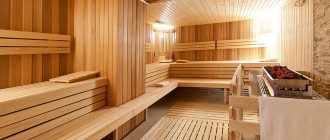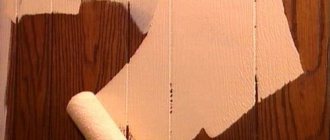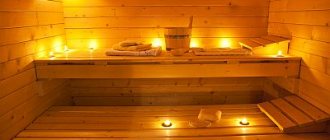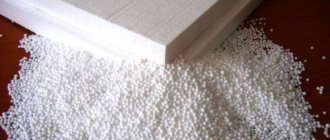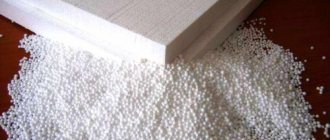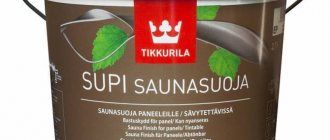The most popular finishing material for a bathhouse is lining; it is made from aspen, alder, pine, and linden boards are often used. This type of cladding is characterized by high performance characteristics: strength, resistance to moisture, steam, and temperature changes.
In order for the wood used to last as long as possible, it must be coated with special compounds that protect against the formation of rot and deformation.
Why is there impregnation in the bath?
Since wood is a natural and absolutely safe material, it is often used for interior decoration. But at the same time, it strongly absorbs moisture, as a result of which the surface becomes loose and is an excellent habitat for microorganisms, in particular fungi. Bacteria that have settled in wooden cladding through their vital activity provoke deterioration of the material and the collapse of the structure.
The market offers a fairly wide range of impregnations for saunas and baths, which are capable of creating a coating that protects the casing from the destructive effects of high humidity and temperature changes. In addition, they have excellent antiseptic properties. The undeniable advantage of such products is the ability to give the surface an attractive appearance, performing the function of a decorative finish.
Note! When choosing impregnation for baths and saunas, you should give preference to products that do not emit toxic substances.
Antiseptic impregnation for a bath allows you to extend the service life of the internal lining, preserve its appearance, and protect it from rotting and mold. These are unique products that do not form a film on the surface of the wood and do not prevent it from breathing.
Rules for applying oil impregnations
- Before applying impregnation, the surface is thoroughly cleaned of dust and dirt and, if necessary, the old coating is removed.
- Then the wood is sanded, dried and the dust and shavings formed as a result of sanding are removed.
- The impregnation is mixed well and applied to the surface with a short-bristled brush.
- Within 7-10 minutes after treatment, remove excess with a soft, lint-free cloth.
- The surfaces are allowed to dry and then polished.
- If necessary, repeat the treatment.
The drying time for each layer ranges from 4 to 24 hours. The exact time required for a particular product to dry is indicated in the instructions. In addition, the drying time is affected by the humidity and temperature of the room, as well as the absorbency of the wood species. In any case, it takes at least a day for the surface to dry completely.
Remember! Wood is only reliably protected from moisture when it no longer absorbs moisture.
What to choose
Specialized retail outlets offer a huge number of impregnations for wooden surfaces; they differ in use, form, and composition.
Before you make a purchase of one or another protective equipment, it is recommended to clearly determine what tasks it should cope with, namely:
- what surface will be treated (floor, ceiling, benches, shelves in the steam room, the entire room);
- will an additional decorative coating be used or will the surface after treatment remain the same as before;
- will the degree of moisture protection inside the bath be sufficient;
- Is the application method convenient?
An essential indicator of high-quality impregnation for baths, including those made from logs, is the combination of its moisture-proof properties with the ability not to prevent the skin from breathing. Since the presence of film leads to blockage of the wood structure and subsequent problems leading to damage to the surface. It is also worth paying attention to the environmental friendliness of the selected antiseptic. Otherwise, low-quality goods at high temperatures and high levels of humidity in the room will release harmful substances.
If impregnation is selected for treating floors, then after its application there should not be a slippery coating. Tabletops and benches should be treated with products designed for regular wet cleaning. There are shelf impregnations on sale that can completely penetrate the wood structure and prevent the formation of burns on the body at high temperatures.
Choosing flaxseed oil for a bath
Flaxseed oil is used both in its pure form and mixed with wax, tar, and turpentine to improve its performance properties.
A mixture with various components is usually used for external impregnation. This is due to the fact that turpentine, for example, is toxic and can cause allergies or cause thermal burns. Tar is less toxic, but has the same disadvantages as turpentine. Beeswax is the only substance a mixture with which can be used for internal impregnation of a bath.
Choose flaxseed oil, which contains the maximum glycerides of linolenic and linoleic acids. It polymerizes faster and has improved protective properties. Please note that pure flaxseed oil should be stored in a tightly sealed container and in the refrigerator.
You can buy natural oil at any pharmacy. Its price starts from 50 rubles per 100 grams. Calculate the required amount according to the principle: 1 liter of oil - per 10 m2.
Industrial bath impregnations based on it additionally include natural resins and pine turpentine. Compositions based on linseed oil from manufacturers Caparol, Rustins, Tikkurila, Remmers are popular. Price - from 300 rubles per liter.
Kinds
Protective impregnations for wooden surfaces are divided into groups depending on the main component in their composition, as well as on the properties and method of application. According to the form of release, antiseptics are:
- aerosol;
- gel;
- in the form of a solution.
All types of impregnations for baths and saunas have water-repellent properties. Modern impregnations for baths rarely have only one function; they can often be used as universal preparations that can also protect wooden surfaces from the negative effects of elevated temperatures, excessive humidity and from damage by pathogenic microorganisms and harmful insects.
Based on their composition, the products are divided into water-soluble and oil-based. You can purchase a combined product in the form of varnish and paint, which is characterized by the effect of moisture protection and prevention from microorganisms. Most impregnations have additional performance qualities in the form of fire resistance and dirt-repellent function.
How to choose impregnation for interior work
If there are still disputes about the steam room, then for other rooms the answer is clear - you need to soak it. Such compositions make the surface much easier to clean from dirt and at the same time help preserve the beauty of the natural material for longer. What you need to pay attention to when choosing.
- Compound. It should be suitable for interior work.
- The time it takes to dry.
Advice. After impregnation has been carried out, the premises can be used only after the composition has completely dried and after ventilation
- What surfaces can be treated (ceiling, walls, floor, interior details).
- How much ventilation do you need?
Impregnation will help protect the wood from rotting and preserve the beauty of the natural material longer.
What it protects from (moisture, insects, pollution, fungus). Paying attention to the composition, you should remember that the impregnation for a bath should have 2 main qualities: repel moisture from the surface and at the same time allow the base to “breathe”. After drying, the applied layer should not be slippery. This is very important when processing floors and shelves. Slippery surfaces can cause falls and injuries.
Differences between oil and water soluble products
The main distinguishing feature of water-soluble impregnations is the base on which they are made - acrylic. An additional component of the product is usually a special coloring color, which gives the treated sauna lining a certain shade. Acrylic impregnations with varnish are now very popular. They are used to treat baths inside and outside.
Despite the many positive characteristics of acrylic preparations, they have one drawback - gradual leaching from the wood structure. To maintain the natural cladding, it is necessary to carry out regular treatments. An excellent solution to this problem would be to first coat the surface with a waterproofing solution and then with bath impregnation. With such an integrated approach, the wood will last much longer.
Due to the absence of color and odor in acrylic, such preparations are especially suitable for interior work. This is a good option for those owners of baths and saunas who want to preserve the natural wood grain. On sale, water-soluble products are presented in the form of dry mixtures or ready-to-use solutions.
Oil impregnations are distinguished by their ability to penetrate deeply into the wood base, leaving a thin film on the outside. They are characterized by durability and can maintain their performance much longer, even at excessive levels of humidity, than water-soluble preparations.
Oil impregnations are characterized by a high degree of toxicity and the presence of an unpleasant, pungent odor, since they contain a solvent. Due to their toxicity, it is not recommended to use these substances indoors without following safety regulations. They can be used to treat the dressing room, outside walls, and utility rooms.
To treat or not to steam room
Some people believe that the steam room is the first place to start wood processing. Others, supporters of everything natural, claim that factory-made chemical compositions are not at all suitable for such purposes. Indeed, under the influence of high temperatures, substances will begin to be released into the air. And what kind of recovery is there now if a person breathes chemicals?
Both are right. The humidity in the steam room is really high, and indeed fungus and mold often grow there. To ensure that the wood does not darken longer and does not lose its properties, you can choose safer compounds or use folk remedies, such as:
- Beeswax. It works well as an impregnation for a bath or sauna. Before application, the surface is sanded well, then a small amount of the substance is melted and applied to a dry, clean surface. Then a film is formed that prevents water from being absorbed into the wood.
- Oil. You can choose, as more economical options, regular sunflower oil, but refined and odorless. Some recommend flax or hemp. You can add natural aromatic oil to your chosen oil to taste.
Appearance of wax packaging for wood impregnation from the range of manufacturers on the market
It must be remembered that for some time such a coating will leave an oily sheen on the body or clothes. Over time, when the substances are absorbed or wiped off, this will no longer be the case, but the waterproof film will still remain.
If the owner is not satisfied with this option, then for finishing the steam room it is better to choose wood from species that are more resistant to damage by fungi. But in a few years you will have to completely change the wooden lining. If you don’t use the bathhouse often, then the wood without impregnation will last about 5 years, but if you use it often, then about 2-3. Here it is up to the owner to choose whether to change the finish or choose an impregnating composition.
Processing different parts of the bath
Conditions in different parts of the bathhouse are different, therefore the requirements for finishing materials are different. In rooms where temperature and humidity are maintained at high levels, it is recommended to choose more expensive durable impregnations.
Waiting room
Among the most popular ready-made products are Sauna (Belinka) and Supi Saunasuoja (Tikkurila). Of the domestic impregnations, the U-409 remedy has proven itself well. It can be equally effectively used for processing wooden structures in baths, saunas, bathrooms, showers and living spaces. All these impregnations are made using only natural ingredients. After their application, a thin film is formed on the sheathing (eurolining) and logs, which greatly simplifies the removal of contaminants. They contain fungicidal and insecticidal components that help prevent the appearance and proliferation of pathogenic microorganisms in baths and saunas, which is especially important for the dressing room.
Another well-known antiseptic is Eurotex Sauna, which contains wax. A colorless wax antiseptic creates a protective film on the surface of a wooden structure. The product is excellent for treating benches and shelves. Impregnation volume of 2.5 liters is enough for 35 sq. m. After using this product, wood has a more attractive appearance, is easier to clean and retains its original color for a long time. The only drawback that can be noted is the presence of a clear specific smell inside the room, but after 3-5 visits it disappears.
Steam room
Considering that the air temperature and high humidity inside the steam room are very high, a special approach is needed here, in particular, you should know how best to treat the lining in the steam room. Natural oils and wax are suitable for these purposes. Some home craftsmen impregnate the boards with linseed oil with the addition of a natural aromatic composition. Often, from a variety of oils, hemp oil is chosen for impregnation. If you need a more economical option, you can use refined sunflower oil.
There is a fairly large selection of products for treating industrial shelves. These are impregnations from Russian and Eurotex Sauna, and Supi Laudesuoja oil from Tikkuril.
Note! It is not advisable to use ordinary paints and varnishes to protect benches, joists, shelves, walls and ceilings.
Wooden surfaces must breathe - first absorb moisture and then release it. If conventional compositions are used, then such surfaces lose this quality. In addition, in conditions of high humidity and high temperatures, the evaporation of harmful substances that pose a health hazard is added, and the bathhouse no longer becomes a cure for many diseases, as it has been for centuries. This can be compared to finishing a bathhouse or sauna with linoleum or siding, which is strictly contraindicated.
Features of oil treatment
- If pure oil (usually linseed) is used, it is heated to 50-60 degrees before processing.
- The composition is applied either with a brush with natural bristles or with a cotton cloth.
- Apply the oil in a thin, even layer.
- The product is applied 5-6 times with layered sanding.
- After covering the next layer, wait for it to dry, then sand and apply the next one.
- It takes at least 2-3 weeks for a surface coated with linseed oil to completely dry.
If a mixture of oil and wax is used to process the bath, then the ingredients are taken in a 2:1 ratio to make it. To prepare the product, add heated wax to hot oil and then mix well.
The mixture is applied with a foam sponge strictly along the fibers. When the first layer has dried, remove the residue with a waffle cloth and treat the surface again.
Homemade recipes
There is a recipe for homemade wax impregnation, which includes beeswax and linseed oil, the ingredients are taken in equal proportions. The grated wax is melted in a water bath, and then it is mixed with the second component and allowed to cool.
It is recommended to use harmless protective materials to impregnate the walls of the steam room. The use of oils allows you to create a greasy film on the surface of a wooden structure and protect the wood itself from penetration deep into dirt. There is one minus here. For some time after contact with the treated surfaces, a greasy film will be felt, but soon the oil will be absorbed and partially erased, leaving only a protective film.
A good result is obtained after using melted natural wax. This impregnation is easy to do with your own hands. But the surface must first be thoroughly cleaned, degreased and only then wax applied.
Why is it necessary to protect all elements of the steam room?
A properly constructed bathhouse has high-quality hydro- and vapor barriers.
Wooden elements: bath bench, shelves, table, etc. must also be protected from external harmful influences. This is especially true for the steam room, where it must be safe and durable. The bathhouse shelf is sanded and covered with Tikkurila antiseptic.
The steam room is the main room in any bathhouse; the shelf needs to be strong and safe. Exposure to hot steam and water makes the tree vulnerable, and without special treatment the canopy will last no more than 1 year. It is not customary to make a canopy made of anything other than wood in a steam room, and this material does not like water. If you take high-quality wood and carry out proper processing, the wooden structure will last a long time.
Initially, it is necessary to take into account the type of wood from which the structure is made. The shelves are made from aspen, which hardens when exposed to water, linden with a pleasant soft texture, it does not heat up at high temperatures, or alder. The latter is difficult to find in construction markets, so it is used less often.
Any type is not afraid of hot steam and is easy to process. The price of the material is higher than that of pine or spruce, but it is better to overpay once. There are several types of wood that are not very common in Russia, but are imported to us from southern countries. These include: abash sedela, ofram, miranti. They have a pleasant texture and are not afraid of moisture and steam. Their prices are high. They are used mainly in expensive finishing.
Any shelf, made from expensive abash or our linden, must be treated with special compounds for the steam room after installation.
You can often hear user reviews that it is better not to process shelves at all. The fact is that incorrectly selected compositions can negatively interact with human skin at high temperatures. The shelves are simply sanded to a completely smooth polished surface. Experts are always debating whether or not to treat shelves. It is impossible to give a definite answer. It is bad not to treat wood, since in bathhouses with poor ventilation the shelves quickly darken and become moldy; it is also not worth treating with a low-quality composition. Everyone chooses for themselves, but if you decide to leave the shelves untreated, then high-quality ventilation is necessary.
What is the benefit of processing
Almost all owners of personal plots who build steam rooms strive to build a room not only for washing, but for comfortable relaxation. That is why they choose natural wood as the building material for the shelves, which is ideal for a steam room. The technical characteristics of lumber make it possible to use wooden boards in rooms with extremely high air humidity, but at the same time, the service life of natural raw materials without pre-impregnation of the shelves is too short.
Since the high hygroscopicity of wood leads to the rapid absorption of moisture, the material of the shelves becomes an ideal place for the appearance of various kinds of microorganisms. The result of all these processes will be rotting of the wood. It turns black, fungus and mold appear on it. Often, the lack of impregnation leads to the accumulation of a large amount of dirt in the pores of the wood, which, in turn, provokes the appearance of parasites in it that destroy the structure of the tree.
Special antiseptics make it possible to reduce the risk of wood contamination, thereby extending the life of wooden shelves and improving the appearance of a product that you may have made yourself.
Today, stores have a huge number of different products that cover the shelves in the bathhouse. They are effective impregnations that not only protect natural wood from rotting, but also give it an aesthetic appearance.
Protecting wood from moisture and rotting
In general, first of all, you need to understand the mechanism of wood rotting itself. Everything here seems to be simple, but it turns out that most people are not entirely familiar with it.
Wood itself is a very durable material. And trees dying in the forest could lie there for centuries and millennia (judging by the preservation of individual wooden objects that archaeologists find in dry places), but nature provides for them to be destroyed under the influence of fungi.
In turn, mushrooms need not only wood to grow and develop, but also water and fresh air. Therefore, they do not settle on dry wood. And they cannot be found under water (the tree is perfectly preserved if completely immersed in water). It follows from this that if you block moisture from accessing the inside of a tree, fungi will not multiply in it.
BY THE WAY! It is impossible to completely destroy mushrooms - their spores are constantly floating in the air we breathe. Therefore, the question is always how to make the conditions for the germination of these spores unfavorable.
Unfavorable conditions include wood that is well dried after bathing procedures, as well as water-repellent impregnations. But you can play it safe and apply another layer of antiseptic under the layer of oil - a substance that makes the wood tasteless or poisonous to fungi.
This article describes in detail which impregnations for wood in baths and saunas help cope with both moisture and rot.
Insulation of steam rooms
In addition to protecting the surfaces adjacent to the stoves, baths (steam rooms) and saunas must be provided with reliable insulation to ensure that the required temperature is maintained.
To insulate steam rooms from the inside, the following techniques can be used:
- the use of heat-insulating non-combustible materials that are most suitable for areas of high humidity in the bathhouse (usually stone or mineral wool is used for these purposes);
- arrangement of vapor barrier protection;
- creation of screens based on non-flammable aluminum foil.
Before starting insulation work, you should prepare the surfaces for laying the selected type of heat-insulating material, which is spread in the niches of the sheathing. A vapor barrier layer is installed on top of the insulation, which can be used as an ordinary polyethylene film.
A special foil film, spread directly on the insulating layer, is also suitable for arranging such protection. Currently, special types of thermal insulation material with a foil layer already present on their surface are on sale.
Decorative lining is placed on top of protective coatings and films, which can be ordinary lining, most common in a bathhouse, or any other heat-resistant material.
What compounds should absolutely not be used?
All wood treatment products have an organic or chemical basis. But here it is worth understanding that the furniture in the steam room is often exposed to high temperatures. Therefore, in order to avoid the release of toxic substances that are found in the compositions of antiseptics and other chemical-based preparations, craftsmen categorically do not recommend using such compositions for furniture in the steam room.
Most often, chemical-based preparations are presented in the form of varnishes or paints. There are also a large number of aerosols, impregnations and other products that contain aggressive chemicals. Therefore, when choosing drugs for shelves, you need to carefully familiarize yourself with its main components.
Protective materials and devices
When choosing protective screens based on sheet blanks for a bath or sauna, the following range of special products offered on the domestic market is taken into account:
- non-combustible asbestos boards;
- steel sheets;
- calcium silicate and other special protective screens, panels, slabs.
According to the requirements of current standards, the need for such non-combustible materials arises only in cases where the distance from the stove to the walls of the bathhouse does not meet fire safety standards. For different types of ovens they vary from 32 cm to one meter.
Sometimes stoves in modern baths are finished with non-flammable tiles made of ceramic or stone. As for wooden materials for decoration and accessories, they all have low thermal conductivity, therefore, although they are not non-flammable, they heat up weakly. For the construction of baths, wood with anti-perenum impregnation, brick, aerated concrete and other non-combustible material are used.
Asbestos sheet
Asbestos belongs to the category of fire-resistant, non-combustible materials that can withstand prolonged heating without loss of strength up to temperatures of about 450-500 degrees.
It can have a variety of designs, including sheet format (in the form of blanks of standardized size). This material is in particular demand in places that are subject to reliable insulation from high-temperature influences (in rooms with thermal and heating stoves installed in them, in particular in baths).
In addition, special fire-resistant partitions for walls and ceilings in bathhouses, as well as insulation of pipelines and thermal connections, are made from asbestos sheets.
Sheet steel and protective screens
Sheet steel is often used as a protective coating for walls in steam rooms, the condition of which is subject to special requirements.
For these purposes, only high-quality metal that is not damaged by rust, purchased in the form of sheet blanks, should be used.
Often, steel sheets are used in bathhouses and to protect floor coverings directly adjacent to the stove, and are used as material for stands.
Protective non-combustible screens are structures that provide insulation from the side walls of the combustion unit in the bathhouse.
They are made of brick or metal sheets and mounted at a distance of no more than 5 centimeters from the surface of the stove walls. From a practical point of view, non-combustible screen structures made from steel blanks or fire-resistant glass are of greatest interest.
Fire-resistant slabs made on the basis of calcium silicate are considered more modern materials for finishing baths. They are used to insulate the walls of the stove in the bathhouse and exhaust ducts.
Water repellent
Let's start with the class of impregnations that are made on the basis of hydrophobic substances. They are intended for wood, because it is wood that suffers the most from water, swelling, increasing in size when wet and shrinking again when drying, with the simultaneous formation of cracks.
These are only the problems against which water-repellent bath impregnations are aimed. In addition, there are related problems, also related to water, which antiseptics combat.
IMPORTANT! Usually a person assumes that impregnation for a bath from moisture will make the wood completely unable to absorb it. In fact, it will only reduce the volume of absorption several times, but, of course, it will not be able to completely block it.
Wood oil
One time-honored recipe for extending the life of wood exposed to water is to apply a coat of oil to its surface.
ATTENTION! Not every oil is suitable for such purposes. There is drying and non-drying. To impregnate wood in a bath, the oil must be dry.
Actually, linseed oil is the most common, most optimal option among natural vegetable oils, which are among the drying ones. Therefore, it has been used for a very long time to protect wood.
One of the developments that improves the properties of linseed oil is drying oil - once it was just boiled linseed oil, which dries faster than raw, then they began to add substances to it that accelerate drying even more - these are driers. At the moment, linseed oil makes up only part of natural drying oil.
We do not recommend using drying oil in a bathhouse, especially in a steam room - there it will not only smell for a long time, but also release far from harmless substances into the air. In other rooms, of course, according to desire or necessity, but still in our time there are other means of protecting wood.
So, flaxseed oil (raw or cooked), which can be bought in a supermarket or pharmacy, remains number 1 among oils for impregnating a bath. It can be applied to any wooden surface, except the floor.
Why shouldn't you apply oil to the floor ? Firstly, because such a coating will not be durable . It wears out easily, and when you walk on the floor, you inevitably wear off its top layer. Secondly, such a floor will become slippery for wet feet. Ready-made compositions for bath floors should indicate that they will not slip.
All other surfaces can be coated with linseed oil. Moreover, this applies not only to the interior, but also to the exterior. The facade is also exposed to atmospheric moisture. Impregnating it with oil is a way to protect not only from water, but from other factors leading to cracking. Practice shows that wood that is impregnated with oil becomes more elastic and cracks to a much lesser extent when its dimensions change under the influence of the environment.
In addition to linseed oil, you can find paraffin oil on sale . Judging by the name, it is made from the heavy fraction of oil, but this should not confuse us, because paraffin is widely used in everyday life and even in medicine (in physiotherapy).
Oils that are found on sale are water-soluble - this is also no reason to doubt. Most likely, this is an emulsion with the addition of various stabilizers to facilitate the application and absorption of the composition into the wood.
Impregnation of the bath with linseed oil
Whatever option you choose - store-bought or homemade - the process of applying linseed oil itself will not differ much. The goal is to apply it and rub it into the surface, making it absorb as much as possible.
The bath can be impregnated with linseed oil using a brush. After application, you can allow some time to absorb, after which the residue is evenly distributed over the surface using a rag. Since we are impregnating the bathhouse, after completion of the impregnation it is worth heating the stove - as the temperature rises, absorption intensifies. The excess needs to be removed.
ADVICE! We have spotted an excellent life hack for deeper impregnation of wood and leather with oil - just use a regular or hair dryer during the application process, with which you warm up the smeared surface, and it absorbs the composition before your eyes.
Application is usually done in at least a couple of layers . In general, you can apply from 1 to 4 layers. Or until the wood stops absorbing (all the oil remains on the surface).
Compositions with wax
Above we did not mention an even more common option - a mixture of oil and wax . The proportions can vary widely, there may even be options for pure waxing of wood, but natural wax is a substance that is solid at room temperature, which is quite problematic to apply.
And in tandem with oil, everything becomes much simpler. However, nowadays there are many ready-made compositions, including water- soluble
In addition to beeswax, is often found in impregnations for baths and saunas with wax . It is a substance that is extracted from the leaves of a palm tree growing in South America.
Carnauba wax - photo: Wikipedia
We mentioned paraffin oil above. It turns out that paraffin is a wax-like substance. In general, waxes are something like fats, but without glycerin. We have no information about other waxes being used in the bath - lanolin, for example, or ozokerite mountain wax.
Wax repels water better than oil and seals wood pores better. We believe that a product based on oil and wax is the best option for impregnating wood for a bathhouse from moisture and rot. Moreover, we note that it protects against rotting only prophylactically , not allowing water to penetrate inside and create conditions for the development of colonies of wood-destroying fungi.

